Abstract
LINE-1 (L1) elements are retrotransposons that comprise large fractions of mammalian genomes1. Transcription through L1 open reading frames is inefficient owing to an elongation defect2, inhibiting the robust expression of L1 RNA and proteins, the substrate and enzyme(s) for retrotransposition3,4,5. This elongation defect probably controls L1 transposition frequency in mammalian cells. Here we report bypassing this transcriptional defect by synthesizing the open reading frames of L1 from synthetic oligonucleotides, altering 24% of the nucleic acid sequence without changing the amino acid sequence. Such resynthesis led to greatly enhanced steady-state L1 RNA and protein levels. Remarkably, when the synthetic open reading frames were substituted for the wild-type open reading frames in an established retrotransposition assay4, transposition levels increased more than 200-fold. This indicates that there are probably no large, rigidly conserved cis-acting nucleic acid sequences required for retrotransposition within L1 coding regions. These synthetic retrotransposons are also the most highly active L1 elements known so far and have potential as practical tools for manipulating mammalian genomes.
This is a preview of subscription content, access via your institution
Access options
Subscribe to this journal
Receive 51 print issues and online access
$199.00 per year
only $3.90 per issue
Buy this article
- Purchase on Springer Link
- Instant access to full article PDF
Prices may be subject to local taxes which are calculated during checkout




Similar content being viewed by others
References
Lander, E. S. et al. Initial sequencing and analysis of the human genome. Nature 409, 860–921 (2001)
Han, J. S., Szak, S. T. & Boeke, J. D. Transcriptional disruption by the L1 retrotransposon and implications for mammalian transcriptomes. Nature 429, 268–274 (2004)
Feng, Q., Moran, J. V., Kazazian, H. H. Jr & Boeke, J. D. Human L1 retrotransposon encodes a conserved endonuclease required for retrotransposition. Cell 87, 905–916 (1996)
Moran, J. V. et al. High frequency retrotransposition in cultured mammalian cells. Cell 87, 917–927 (1996)
Cost, G. J., Feng, Q., Jacquier, A. & Boeke, J. D. Human L1 element target-primed reverse transcription in vitro. EMBO J. 21, 5899–5910 (2002)
Dewannieux, M., Esnault, C. & Heidmann, T. LINE-mediated retrotransposition of marked Alu sequences. Nature Genet. 35, 41–48 (2003)
Martin, S. L. Characterization of a LINE-1 cDNA that originated from RNA present in the ribonucleoprotein particles: implications for the structure of an active mouse LINE-1. Gene 153, 261–266 (1995)
Kolosha, V. O. & Martin, S. L. In vitro properties of the first ORF protein from mouse LINE-1 support its role in ribonucleoprotein particle formation during retrotransposition. Proc. Natl Acad. Sci. USA 94, 10155–10160 (1997)
Esnault, C., Maestre, J. & Heidmann, T. Human LINE retrotransposons generate processed pseudogenes. Nature Genet. 24, 363–367 (2000)
Wei, W. et al. Human L1 retrotransposition: cis preference versus trans complementation. Mol. Cell. Biol. 21, 1429–1439 (2001)
Mathias, S. L., Scott, A. F., Kazazian, H. H. Jr, Boeke, J. D. & Gabriel, A. Reverse transcriptase encoded by a human transposable element. Science 254, 1808–1810 (1991)
Stemmer, W. P., Crameri, A., Ha, K. D., Brennan, T. M. & Heyneker, H. L. Single-step assembly of a gene and entire plasmid from large numbers of oligodeoxyribonucleotides. Gene 164, 49–53 (1995)
Boissinot, S., Chevret, P. & Furano, A. V. L1 (LINE-1) retrotransposon evolution and amplification in recent human history. Mol. Biol. Evol. 17, 915–928 (2000)
Gilbert, N., Lutz-Prigge, S. & Moran, J. V. Genomic deletions created upon LINE-1 retrotransposition. Cell 110, 315–325 (2002)
Symer, D. E. et al. Human L1 retrotransposition is associated with genetic instability in vivo. Cell 110, 327–338 (2002)
Cost, G. J. & Boeke, J. D. Targeting of human retrotransposon integration is directed by the specificity of the L1 endonuclease for regions of unusual DNA structure. Biochemistry 37, 18081–18093 (1998)
Wei, W., Morrish, T. A., Alisch, R. S. & Moran, J. V. A transient assay reveals that cultured human cells can accommodate multiple LINE-1 retrotransposition events. Anal. Biochem. 284, 435–438 (2000)
Moran, J. V., DeBerardinis, R. J. & Kazazian, H. H. Jr Exon shuffling by L1 retrotransposition. Science 283, 1530–1534 (1999)
Hamer, L., DeZwaan, T. M., Montenegro-Chamorro, M. V., Frank, S. A. & Hamer, J. E. Recent advances in large-scale transposon mutagenesis. Curr. Opin. Chem. Biol. 5, 67–72 (2001)
Ostertag, E. M. et al. A mouse model of human L1 retrotransposition. Nature Genet. 32, 655–660 (2002)
Haas, J., Park, E.-C. & Seed, B. Codon usage limitation in the expression of HIV-1 envelope glycoprotein. Curr. Biol. 6, 315–324 (1996)
Naas, T. P. et al. An actively retrotransposing, novel subfamily of mouse L1 elements. EMBO J. 17, 590–597 (1998)
Morrish, T. A. et al. DNA repair mediated by endonuclease-independent LINE-1 retrotransposition. Nature Genet. 31, 159–165 (2002)
Acknowledgements
We thank Boeke laboratory members, especially Y. Aizawa, for helpful discussions and critical reading of the manuscript. We thank A. Yetil for assistance. This work was supported by the NIH (J.D.B.) and the Medical Scientist Training Program (J.S.H.).
Author information
Authors and Affiliations
Corresponding author
Ethics declarations
Competing interests
The authors declare that they have no competing financial interests.
Supplementary information
Supplementary Legends
Legends for Supplementary Tables S1, S2 and Supplementary Figure S1 (DOC 30 kb)
Supplementary Tables
Supplementary Table S1:Oligonucleotides used; Supplementary Table S2: Codons used to synthesize smORF1 and smORF2. (PDF 17 kb)
Supplementary Figure S1
Alignment of native mouse L1 with synthetic mouse L1. (PDF 123 kb)
Rights and permissions
About this article
Cite this article
Han, J., Boeke, J. A highly active synthetic mammalian retrotransposon. Nature 429, 314–318 (2004). https://doi.org/10.1038/nature02535
Received:
Accepted:
Issue Date:
DOI: https://doi.org/10.1038/nature02535
This article is cited by
-
Autonomous transposons tune their sequences to ensure somatic suppression
Nature (2024)
-
Retrotransposon instability dominates the acquired mutation landscape of mouse induced pluripotent stem cells
Nature Communications (2022)
-
LINE-1 ORF1p does not determine substrate preference for human/orangutan SVA and gibbon LAVA
Mobile DNA (2020)
-
Variation in base composition underlies functional and evolutionary divergence in non-LTR retrotransposons
Mobile DNA (2020)
-
Tracing the history of LINE and SINE extinction in sigmodontine rodents
Mobile DNA (2019)
Comments
By submitting a comment you agree to abide by our Terms and Community Guidelines. If you find something abusive or that does not comply with our terms or guidelines please flag it as inappropriate.



